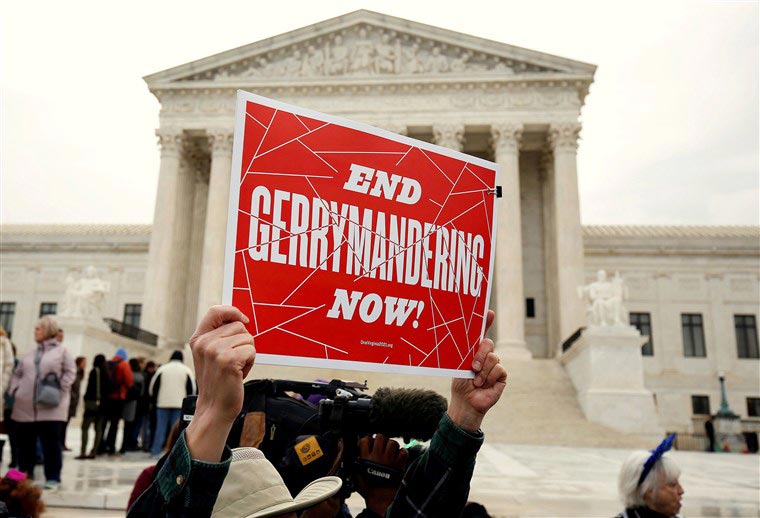Gerrymandering
The Gerrymandering Blog was created as an interactive and timely educational tool that gives you the freedom to publish content on our website. The intent is for you to effectively comment on the topic and provide accurate and factual information to assist our membership in recognizing and resolving issues in government and policy. Your participation with an accurate, appropriate and quality post will help us implement your ideas into our Classrooms, our Facebook Teams and our Advocacy Groups. You are welcome to join in the dialog.
Gerrymandering is the act of politicians manipulating the redrawing of legislative district lines in order to help their friends and hurt their enemies. They may seek to help one party win extra seats (a partisan gerrymander), make incumbents of both parties safer (an incumbent-protection gerrymander) or target particular incumbents who have fallen out of favor. Those engaged in gerrymandering rely heavily on winner-take-all voting rules. That is, when 51% of voters earn 100% of representation, those drawing districts can pack, stack and crack the population in order to make some votes count to their full potential and waste other votes. Gerrymandering has become easier today due to a combination of new technology to precisely draw districts and greater voter partisan rigidity that makes it easier to project the outcome of new districts.
Independent redistricting commissions and other public interest changes to redistricting are important, but trying to fix gerrymandering fully within winner-take-all voting rules is simply impossible.
Addressing Gerrymandering
The key to fixing gerrymandering is changing key statutory laws for how elections are held. Check out our resources:




Trump’s Election Is a Disaster for the Climate—and an Opportunity
For climate activists, the current moment is almost unbearably bleak. But the task is clear: to build a mass movement that completely overhauls our current political system.
It was 3 a.m. on November 6. The baby growing inside me kicked hard as yet another set of Electoral College votes flashed red on the TV screen for Trump. I couldn’t help but wonder if the kicking was her own act of protest in the waning hours of the 2024 election. After all, this child is the progeny of two environmental activists who have spent decades fighting the climate emergency, particularly federal fossil fuel production. It’s difficult to describe how grim that work looks right now.
But this is also the moment to radically reimagine and rebuild our political system into one more responsive to people’s needs. That’s the potential of the next four years. It’s the transformation we need to meet the climate catastrophes ahead, far more powerful than Trump himself.
Today’s reality is harsh: The United States is the world’s largest oil and gas producer and liquefied natural gas exporter, and fossil fuels are the dominant cause of climate chaos. Both the Trump and Biden administrations reached record oil and gas production during their successive terms.
The Biden administration had a complex relationship with the climate crisis, embracing both clean and dirty energy as part of an “all of the above” approach that contradicts scientists’ recommendations to safeguard the planet. Biden passed historic clean energy investments with his signature climate law, the Inflation Reduction Act. But that act also included additional oil and gas leasing on our public lands and waters. The administration then approved ConocoPhillips’s devastating Willow Project in Alaska, the nation’s largest oil drilling operation. In response to pressure from environmental justice communities and climate advocates, Biden also imposed a moratorium on new federal oil and gas leases in 2021 and paused approvals for new liquefied natural gas terminals in 2024—bold moves that were eventually blocked by federal judges.
Now we face the unfettered Trump 2.0 era, led by a man who shamelessly cheered “Drill, baby, drill” and called climate change a “hoax” at his political rallies and appointed an ExxonMobil CEO to his first Cabinet. All signs suggest this administration will focus on gutting environmental protections and padding the bloated pockets of fossil fuel corporations and their billionaire executives and shareholders.
For climate activists, Trump’s ascent means federal avenues to fight fossil fuels will be mostly blocked. Our three branches of government, designed to check one another and thwart abusive power, are now at risk of being monopolized by a climate-denying fascist.
Trump has vowed to ditch virtually all Biden administration regulations intended to cut carbon emissions and move away from fossil fuels. He will seek to slash positions of federal employees who have spent their careers trying to protect our air, water, and wildlife.
While the House of Representatives’ election results aren’t yet final, it’s clear that a Republican Senate will block any climate-fighting legislation. And the Supreme Court is severely compromised by its radical right wing. Trump has promised to replace Justice Samuel Alito and Justice Clarence Thomas with younger judges who could secure a radical-right majority at the highest court until my unborn daughter is in her thirties. Without material reform to expand the court, this doesn’t bode well for multiple generations of women, as well as the working class, communities of color, migrant families, transgender people, and our imperiled ecosystems.
As many in the environmental movement have said this past week, we will resist as we did the first time. Biden has committed to filling the nearly 50 open judicial vacancies before leaving office. This move, if he can accomplish it, will be a vital lifeline to ensuring integrity of the judiciary at district and appeals court levels.
As a lawyer who was part of the record onslaught of lawsuits against Trump during his first term, I think it’s important to note that 90 percent of our lawsuits were successful. They acted as a crucial bulwark against Trump’s attacks on our climate, health, and safety.
But resistance alone, which maintains the status quo, is no longer enough. The election refuted that notion, and the world’s environmental chaos confirms it. Our current system has driven the planet to break 1.5 degrees Celsius (2.7 degrees Fahrenheit) of warming this year. The Paris Agreement set this threshold as a dangerous tipping point for the world’s poorest communities, who disproportionately bear the brunt of climate change’s horrific consequences while the wealthiest disproportionately pollute.
We need to only look at the last year to see that when climate chaos tested the country, the current system failed. The cataclysmic Hurricane Helene, record heat waves, and relentless wildfires stole lives, demolished homes, wiped out jobs, and left survivors in profound social, economic, and emotional instability.
To survive and thrive during the next four years and beyond, we have to build our political system anew. We need to reimagine how our politics can be genuinely responsive to what people need—not under the hateful rhetoric of the Republicans or the willful ignorance of the Democrats.
Building a responsive political system starts on the ground, driving intersectional solutions to climate chaos that are both community-focused and deeply resourced. The climate movement has to fully break out of its silo and build real political power with youth, labor, working families, migrants, the LGBTQ+ community, and other rights-based groups to grow a broad-based movement that centers justice at every step. Climate activists within the movement have already made important inroads in this intersectional organizing—including last year when hundreds of thousands around the world marched in the first mass mobilization to end fossil fuels—and we have many miles to go.
Faced with an intractable federal government, activists can also take their battle to the states, for example fighting the detonation of carbon bombs like the Permian Basin. My colleagues at the Center for Biological Diversity, together with Indigenous, frontline, and youth groups, recently filed a landmark case challenging the state of New Mexico for failing to uphold its constitutional duty to control oil and gas pollution and protect the health of its residents. Responding to pressure from local groups, the state also has created health buffers aimed at preventing schoolchildren from being poisoned by the oil industry as they sit in their classes.
The byzantine world of state public utility commissions is also ground zero for bucking the racist, fossil fuel–dependent electricity system and designing democratic and affordable energy systems that serve the public’s interest. These black-box commissions—long dominated by regulators captured by fossil utilities and drowned in technical jargon to confuse the public—are the front line of deciding state energy policy.
Mass organizing of communities harmed by predatory utility rates, shutoffs, and fossil fuel pollution can force these commissions to respond to people, not monopoly utility providers that have stifled alternative distributed energy to protect their profits. State utility commissions can ramp up rooftop and community solar systems and other renewable energy sources that displace polluting fossil fuels; loosen the death grip of corporate utilities; and make electricity affordable, clean and democratic. This isn’t just a fight against the climate emergency—which can feel abstract to some people. It’s a fight against entrenched power that threatens people’s pocketbooks, their health, and their livelihoods.
While we are all trying to make sense of what happened and why, our next steps are clear. The status quo needs to change, and it’s up to us to organize a new, intersectional mass people’s movement that can create the momentum for and help design the systems that will get us there. It may be that my daughter’s strong kicks are her way of signaling that she’s raring to go. Fighting for a safe climate means fighting on every front for a chance of something that looks like justice.
Gerrymandering is a problem. The is a process. https://youtu.be/gRCZR_BbjTo